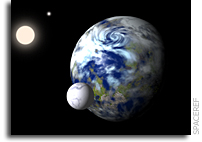Universally Speaking, Earthlings Share a Nice Neighborhood

New computer simulations put solar system in universal perspective.
Jupiter may act as our solar system’s “junk yard dog,” protecting the Earth from comets.
View a video interview with theoretical astrophysicist Ed Thommes of the University of Guelph.
We don’t have spacecraft to take us outside our solar system–not yet, at least. Still, astronomers thought they had a pretty good understanding of how our solar system formed and in turn, how others formed. In the last dozen years, nearly 300 exoplanets have been discovered. Are the solar systems in which they reside indeed like our own? Without knowledge or observations to the contrary, conventional knowledge said yes. Three Northwestern University researchers questioned that assumption and explored this question. What they learned is that the solar system in which the Earth orbits our sun is actually uncommon.
Edward Thommes, Soko Matsumura and Frederic Rasio were the first to develop large-scale, sophisticated computer simulations to model the formation of planetary systems from beginning to end. Because of computing limitations, earlier models provided only brief glimpses of the process. The surprising findings of their study titled, “Gas Disks to Gas Giants: Simulating the Birth of Planetary Systems,” are detailed in the August 8, 2008 issue of Science magazine.
The researchers used a range of computer simulations to explore the formation of extra-solar planetary systems. They were able to show the action of a planet-forming circumstellar disk in three different starting condition scenarios at different intervals from the beginning of the universe to 500 million years of evolution. They found that our solar system represents the rare case in which big gas giants form, but do not migrate to the inner planetary system, and the orbits of all of the planets in the system are circular and stable.
“We now know that these other planetary systems don’t look like the solar system at all,” said Frederic A. Rasio, senior author of the Science paper, and a theoretical astrophysicist and professor of physics and astronomy in Northwestern’s Weinberg College of Arts and Sciences. “We now better understand the process of planet formation and can explain the properties of the strange exoplanets we’ve observed. We also know that the solar system is special and understand at some level what makes it special.”
The computer simulations were performed on a supercomputing cluster operated by Northwestern’s Theoretical Astrophysics Group and partially funded by a Major Research Instrumentation grant from the National Science Foundation (NSF). Rasio’s research group on exoplanets also is funded by a grant from the NSF Division of Astronomy.
-NSF-
Media Contacts
Lisa-Joy Zgorski, NSF (703) 292-8311 lisajoy@nsf.gov
Megan Fellman, Northwestern University (847) 491-3115 fellman@northwestern.edu
Principal Investigators
Edward Thommes, University of Guelph ethommes@physics.uoguelph.ca
Frederic Rasio, Northwestern University 847-467-3419 rasio@northwestern.com









